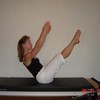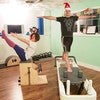Description
About This Video
Transcript
Read Full Transcript
Hi, I'm Portia page and I'm here to talk to you today about movement principles for training for everyday life, but also for those athletic conditioning moves that we all like to do on our time off or just when we're having fun or maybe you do play a sport and with me today I have Erica quest and she is also known as e dog. I'm p dog and we're going to have a little bit of fun with movement and some training principles. So the first one I want to talk about when we train for life or athletic conditioning, we need to look at the body as a whole. So we look at whole body movement as in walking runny, yes. Or as some lateral stuff, right? Any of that stuff. We want to look at the body as a whole and see how, let's see you do that again.
Can you just side to side yet or Yep. Case. We want to look at her from a whole, from her hair to her toenails, right? And see how the body is moving as a whole. Then we also want to look at her in movement from a planar perspective. So if she is walking like a robot, we're gonna look at the sagittal movement and see what's happening in flection and extension of the body.
Also we want to look from not just sagittal but coronal and what you'd like to do. Some coronal moves for me. Yes, side to side. So we're going to look at is the movement balanced on both sides. Also we are looking at rotational, right? Or the transverse plane of movement. And the transverse plane is where we actually get most of our athletic ability from.
Because if you'll notice actually if you can reach for your toes and then reach up to the corner there. So this, we're actually getting lots of different movement. We're getting sagittal movement, we're getting the rotational or getting some coronal. We're getting a little bit of everything here and this is a really great place to look. Thank you. You've done enough of that. Yeah. I don't want you to get unbalanced or anything. Okay. And then we also want to look at Erica at specific points or the local view.
And the local view would be how is this elbow don't joint moving and working and how is the knee joint moving or working hip joint, all of that. And then we want to go back to the global view, maybe back to local and then in and out from there. So we will again want to look at her whole body specific areas of movement and then particular areas that she's moving. Once we have that down, I want to look at or we want to look at core integration. What is core mean? What is core integration mean? Core integration is looking at the whole body and movement and how movement affects the core and how placement or strength or weaknesses in the core effect movement. So it's integration of the core.
We all know about that inner unit, right? Our inner deepest unit, our inner core, that is our stability core stability core. Even when Eric has just standing here looking as lovely as she is right here, her inner unit is working so that if I came up and gave her a little shift, she's not going to fall over like that, right? Because she's so strong. Her inner unit is supporting the pelvis, supporting the ribs over the pelvis and keeping her body upright. Now when she starts to move, then we need to look at the outer unit and this is our mobility core and we're going to do a little demonstration here of two pieces of the mobility core. You can stand on the mat because she for your feet. All right, so when we look at the outer unit, this is the unit that brings movement to the joints, to the body itself.
And we have two systems of front and back system, Anterior Oblique, sling and Posterior Oblique sling. Our anterior slang, just going to show you with this blue band here comes from, excuse my reach there. Okay, so we have our serratus anterior, the obliques, inner and outer, or excuse me, x. I always get external and internal, internal, internal, external, whatever. Okay, so we have our obliques and then it goes to the opposite side. Add doctor. So what I'm going to do is take the band, excuse my reach here. Miss Erica, come around and she's going to grab it from the outside here. Okay, so we have one sling on. That means if she only had this one sling working, she'd be a little bit lopsided. She would move very strangely. Okay. Now we're going to sling on our other one here. Again, that's Serratus the obliques to the opposite adductor. Don't worry, I'll, I'll get you strapped in here. Okay, ready to go.
All right, so she has her slings on. Now we talked about the anterior, the front sling. I'm going to have her turn around. We're going to demonstrate the bar. Have you see the posture, your Oblique, sling illustrated, posterior oblique sling is [inaudible] Ms. Dorsey and gluteals. Right?
So we have this slang here and we see nice little sling right over the gluteals and into the opposite. Well, sort of opposite it go. It would be like this. Okay. And then from this side it would be like that. I don't want to make it too uncomfortable for her, but you get the idea. So now we're going to keep her here. She's going to do a little bit of extension. So as she goes into extension, you can see that these are actually, well, they should be tightening.
It's a little difficult to see. But turn to the side. Now come back to this and show extension again. So these slings titan as the front slings lengthen as she goes into flection. The posterior Oblique slings lengthen and the anterior ones shorten. So come on up now we'll show you in rotation what happens.
You can see how the slings help to facilitate movement. Excellent. You can let go of your slings down, Darling. All right, so there was our quick Dr Seuss way of illustrating the anterior and posterior slings. So you could see how your mobility core works in a small degree. We have a couple of other pieces of that core that help us to move. One of them is the lateral system. So if Miss Erica is standing here facing you, she's going to shift her weight onto one leg. Okay. And now I'm just going to have her hike up and down her left hip. Whoa. I know.
Hang on to that balance there. So now we're looking at her lateral slings and the lateral slings provide that column of support around the hip joint. So we have the outer thigh of one leg, inner thigh of the other leg, and vice versa. So those two slings work together to provide balance from the lateral and the medial side of her body. You can take a quick rest there. I know balancing on one leg can be really hard, especially on a mat, a thick mat. And then we have another system, the deep longitudinal system, which basically just provides that athletic power of all of the muscles in the back. So if you just do a quick turnaround here from lovely, what's underneath this hair here, the head, all the way down to the lovely heels, all of those muscles in the deep longitudinal system work to provide that athletic chain of power that help propel you to wherever you need to be propelled with this hair. Who knows where you might be going? All right, so there's our quick explanation of the outer unit that again, that's our mobility core.
That unit is extremely important in training athletes or just like I said before, athletic warriors of life, which we are, right? Yes, and that's what we're here to learn about. So now I want to talk about, we've got the whole body movement, global patterns, planar patterns, local patterns. We've also got the inner and Outer Unit Jive in and moving together. Now I want to look at upper body and lower body, upper body. We want to talk about muscular balance and strength and stability with the lower body. We want to talk about muscular balance and power because it's the power from the legs that transfers through our core into the upper body that creates that beautiful athletic movement that you're looking for in your clients and your clients who are looking for to get from you. Okay, so now let's talk about the upper body first. Shall we Miss Erica?
When we talk about the upper body, we want to train for four different things. The first thing is going to be actually why don't you face to the front first? Yes. Okay. First thing, we want to look at his rotator cuff strength. So when we're training for the upper body, we need to get our humerus placed correctly in the glenoid Fossa so that those muscles that support the Scapula and the shoulder can actually create our movement at that's balanced and efficient and injury free. So you want to look at rotator cuff strengthening.
That's endurance work in this internal and external rotation here of the humerus itself. It's small movement, it's muscular endurance. So that means you can do a lot of repetitions at a lightweight. Alright here we're doing no weight and just working against gravity bands are an excellent way to do that. The next thing that you want to look at is full range of motion in the shoulder itself. So now I'm going to have you turn around. You can step on the map to your feet or cushion. Yes, I know will be nice.
You have to balance though. Okay, you ready for that? Okay. So first we're going to have her bring her arms in front here. So both arms in front, she's going to show range of motion in protraction and retraction. So if you just bring your arms forward and back, you can see the muscles around the scapula working right to hopefully create a nice even glide of the scapula along the rib cage itself. How cool is that? Now let's bring the arms down and up.
So just from the hips straight over the heads. Okay. Not to the side though, just yet. Right in front of you. Yep. So we see again, shoulder movement, right? The scapular, hopefully gliding evenly over the rib cage. There is movement. We want that movement to be pain-free. We want it to be efficient and we want it to be crackling if you get my point. So a lot of times if we were listening very carefully to Erica shoulders, we might hear some cracking. Are you hearing any cracking? Oh, wonderful. That's a good thing. Now let's try upward and outward rotation.
So I'll move a little bit to the side and we'll bring her arms out to the side and up. And we see that beautiful little gliding of the Scapula. Just gorgeous here. Yeah, the little wings of love are really just gliding evenly along there. So this is another pattern of movement that we're looking for. Ease and efficiency. All right? Now once we have all of the ranges of motion that we need, okay, we can also do some elevation depression. So elevation, they're happy, happy Scapula, and now they're Diprose. Now they're happy.
I now they are depressed. Okay. We would like them to be somewhere in the middle. So not on the Prozac, but not on the happy pills either. So somewhere in between there to where there's nice even work here in the upper back and the upper neck and nice support here from the lower half and just a nice happy smile here at the Scapula. Once we have the range of motion, now we need to get this woman prepped to be able to hold planks and do pushups and all the fun stuff that she does. Even surfing right, and yoga on your standup paddleboard. All of those things are really important to have scapular stability.
So with scapular stability, let's have you come down into a modified, oh no, let's do all fours. Yep. All fours. So here in this position we're looking again, we had her in an upright position so there was no tension in the upper body whatsoever. She just had her arms out in front, she was showing you protraction and retraction. Now we're going to do that protraction and retraction with a sternum drop so we can see the scapula gliding and together into abduction and now we see the abduction as they pull apart and we want to see a really nice range of motion here where we get that separation and then that drawing together, she is doing a really nice job of only dropping just the sternum area down in, up, keeping the low back, the lumbar spine, the pelvis, all in this nice stable position. She's also keeping the head in line with this spinal column right here and we want to see a nice glide here. All right. Once we have this, we again find that middle or neutral position and then she can do 500 pushups from here. I'm not really gonna ask her to do that, but this is, I'll just mention right now is a fantastic place to start. Push ups in this all four position.
So let's just have you take two different pushups here. Your to bend your elbows towards your thighs and let your hips drop down and then come back up. There's one, the second level would be bringing the weight forward as she bends the elbows and lowering down so the hips stay over the knees. Great ways to prep for a pushup. Here's the all fours version. Now if you just want move your hands a little bit more forward and then extend your hips. Good. Keeping the knees down. She can do the same thing.
Just drop down and up into a pushup. I know she could do full toes push up, but this would be the next level. Okay. From here, just tuck your toes, straighten your knees and we'll have her do one push up here cause she's so good at this. Yeah. Oh Nice. Okay. Here's a great way to support your client too. If she gives me one more, I'll show you a nice way to support. Yes. Beautiful. Because then she can feel her abdominals working. She's got her whole inner unit supporting the outer unit, working the whole entire body to keep herself steady. You can lower your knees now. Nice job.
So there was our upper body, the first three training principles, again, strengthening the rotator cuff, um, range of motion in the Scapula, scapular stability. And then the final thing that we would want to do are the functional movement patterns of the Upper Body. And those might be pushing yes and pulling right and putting something overhead. Yes. For us, that would be maybe putting our baggage in the overhead bin and not having to ask somebody to do it for us. Right? Or putting something down below. So maybe putting your bag underneath the seat, right.
And then pulling it in from there. So all of those movements, the pushing, the pulling, the driving overhead, the pushing down, the pulling up, all of those are upper body strength that we need to work on. Now let's go to the lower half. All right. Leg Strength and power with leg strength, we want to have a muscular balance around the feet, the ankles, the knees, and the hips. Let's start at the top at the hips. So with the hips we have range of motion. What can your hips do? Erica? Flection extension, right?
How about some abduction? Abduction, right? So moving away from the midline and towards midline circumduction right? All of these ranges of motion are extremely important when you are doing athletic activities or just things like walking, running or surfing or playing tennis, right? So now we have hip mobility. These are all the things that your hips can do. Now we want to talk about muscular balance around the knee joint.
Why is that so important? Well, our knees have to hold us up when we're standing. They have to kick a ball, they have to rotate the body, the lower limbs. As we play golf, they need to hold us up on a surfboard. They need to keep bending and extending. So when we run, all of those things are super important. So the knees, they need to have muscular balance to keep the joint safe. And that means that we want to work quadriceps, we want to work the hamstrings and we want to keep the balance between the two. So if I had, well, I'm a really good example of quad dominant, I have to work my hamstrings all the time because they're in the back of my body. I forget that they're there for some reason, my quads, I just look at them and they explode. Yes.
So for me it's really important that I keep the muscular balance in the hamstrings so that I don't injure my knee because my normal stance is here, which is not good. Right? I want to feel that lift up out of now Erica doesn't have that problem. She's perfect. All right, so muscular balance around the need, very, very important. The knees transfer, the power from, or the forces from the bottoms of our feet up into the hips and then they take the gravity and transfer that forces from the hips down to the feet themselves. So they are like the connection point between top and bottom.
Extremely important that we keep them safe and that's what we want. Muscular balance around them. The other thing that we want to think about is the ankles, right? So it's really important to have full range of motion in the ankles and full range of motion in the muscles of our feet. So working on elevation and so lifting and lowering of the heels, strengthening the ankles. Yep. Getting full range of motion.
All of those things are really important when it comes to the feet, the knees and the hips. And again, going back to why we want there to be strength and power in our legs. Why is that? Miss Erica? No, because channel or interests, yes. Chan channeling our inner athlete. Yes, that's right. Good job. So there you go. Some simple concepts for training the inner athlete that we all have inside of us, the one that wants to come out on the weekends, during the week, in the evenings or whatever time of day it might be. Or maybe you are training actual athletes who do need that leg strength and power, upper body strength and power. It doesn't matter. We all need it because everyday life requires a strong athletic body that can carry you to and fro and up and down and side to side.
Thank you very much.
Comments
You need to be a subscriber to post a comment.
Please Log In or Create an Account to start your free trial.



















